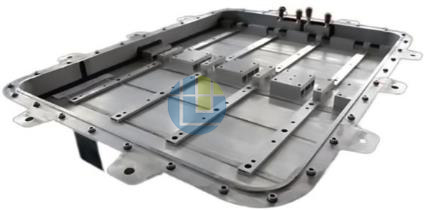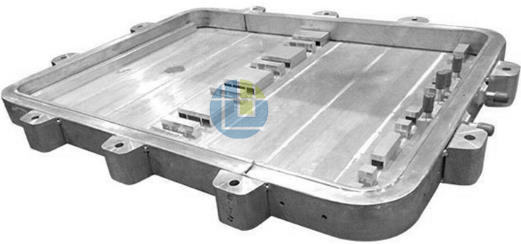Do You Know The Aluminum Tray For New Energy Electric Vehicles?
- By:sjhmalu
- Date:16-11-2022
Development Prospects of New Energy Vehicles
The automobile industry is developing rapidly, but the energy problem is becoming more and more urgent, and the environmental problems caused by automobiles have also attracted much attention. The development of the new energy automobile industry is an effective way to alleviate the energy crisis, reduce greenhouse gas emissions and reduce environmental pollution. At present, new energy vehicles have become an important direction for the transformation of the automobile industry.

The difference between new energy vehicles and traditional vehicles that use fuel as power is that new energy vehicles use batteries as the power to run the car. The things to consider here are the weight of the power battery, the cruising range of the battery, and the energy saving and emission reduction of the car. In the implementation of the policy, in the application of automobile design and materials, the weight of the car body is the first thing to consider, and the weight reduction of automobiles is imminent. Therefore, compared with traditional automobiles, battery-powered new energy vehicles need to further reduce body weight. At the same time, it has also opened up a broad market space for aluminum materials, and the application of aluminum materials in automobiles has greatly increased.
Among the lightweight materials for automobiles, the comprehensive cost performance of aluminum alloy materials is higher than that of steel, magnesium, plastic, and composite materials. It has comparative advantages in terms of application technology, operational safety, and recycling. The density of aluminum materials is only one-third of the previous one. , its weight reduction and energy-saving effects are obvious, and it can better improve ride comfort under the premise of ensuring safety. At the same time, aluminum materials are easier to recycle and reuse, and the comprehensive cost-effective advantage of aluminum materials determines that it becomes a lightweight application s Choice.
In today’s automobile market, with the increasing attention paid to the lightweight of automobiles, the lightweight of aluminum alloy battery case structure has become one of the more widely discussed technical topics in the industry. Based on the expectation that the subsidies for new energy vehicles will be canceled after 2021, the traditional battery case materials will also usher in a new opportunity.
With the development of energy conservation, environmental protection, and lightweight of automobiles, various lightweight material choices such as glass fiber reinforced composite materials, SMC sheet materials, and carbon fiber composite materials have also appeared in battery case materials. However, due to factors such as technology and cost, these materials have not yet been used on a large scale.
At present, aluminum alloy materials are mostly used in the battery case of new energy vehicles. The material density of the aluminum alloy battery pack shell is low, and it is easy to meet the subsidy requirements of the energy density of the battery system. Therefore, the current consumption is relatively large and has become mainstream.
Today, when lightweight energy vehicles have become the general trend, traditional raw material suppliers have reached cooperation with battery suppliers to explore more cost-effective and popularized lightweight battery pack solutions. At present, aluminum alloys are mostly used in power battery packs, and traditional steel plates are gradually replaced by aluminum alloys due to their lack of lightweight advantages.
As the sales of new energy vehicles increase, solutions with more economies of scale will also enter the market. Whether it is steel plate, aluminum alloy, or carbon fiber, it will be re-inspected by OEMs, and cost, safety, and cruising range are the core issues they care about.
Aluminum alloy battery case is the preferred material to replace steel, with the advantages of a lightweight, having high structural strength, good heat dissipation, and good corrosion resistance. The power battery pack structure has a cast aluminum structure and profiles welded structure. The disadvantage of cast aluminum structure is that the wall thickness is large, the amount of machining is large, and the weight reduction is not obvious. The profile welded structure has the advantages of being lightweight, small machining amount, good profile adaptability, and high strength, but the disadvantage is that the profile weldability is poor, the welding strength is weakened, and the welding deformation is large. But now the rise of advanced welding technology, friction welding, ultrasonic welding, and other technologies have solved the problem of aluminum alloy welding, and the application of aluminum materials for new energy battery shells is becoming more and more extensive.
Application of aluminum in new energy vehicle parts
The application parts of aluminum in new energy vehicle parts mainly include the body, wheel hub, chassis, anti-collision beam, power battery, and seat. According to processing, aluminum for automobiles is mainly divided into three forms: die-casting, extrusion, and rolling, of which the consumption of die-casting parts accounts for about 80%, and the extrusion parts and rolling parts each account for about 10%. Die-casting parts are mainly used for engines, wheels, etc., extrusion parts are mainly used for cars, luggage racks, door beams, etc., and rolled parts are mainly used to produce aluminum plates for car bodies, etc. Each aluminum part can be well used in new energy on the car.
The body includes a body frame made of high-performance aluminum profiles, skins, and doors made of high-precision aluminum sheets; aluminum alloy wheels (cast aluminum wheels or forged aluminum wheels); chassis includes high-strength large-section aluminum structure parts and aluminum alloy forgings; Anti-collision beam bumper made of profiles; new energy bus floor; lithium-ion battery including battery positive aluminum foil, battery aluminum shell and battery aluminum tray (European and American battery trays are all made of aluminum alloy, domestic battery trays are both aluminum alloy and stainless steel)
What are the advantages of aluminum alloy in the application of new energy vehicles?
In the automobile market in recent years, the new energy automobile industry has developed rapidly, and with the vigorous implementation and application of sustainable development strategies, automobile lightweight has become a trend of world progress. In the process of lightweighting of automobiles, the application of aluminum alloy materials is particularly outstanding. It is mainly used to transform and replace raw materials for car bodies. The lightweighting of automobiles mainly includes three categories: body, chassis, and engine. While ensuring the performance of the car, the weight of the car is reduced by using aluminum alloys and other materials to achieve energy conservation, environmental protection, and sustainability. What are the advantages of aluminum alloys in the application of new energy vehicles?
The first point: aluminum alloys are easy to recycle and reuse. Aluminum products are not prone to corrosion or slight corrosion during the application process. Among the conventional raw materials used in industry, aluminum has the greatest recycling value. Recycling, aluminum raw material is only 5%, although its recycling performance is non-standard aluminum, it is higher than any of the more commonly used metals.
The second point is: weight loss and energy saving and environmental protection effects are remarkable. Aluminum has good mechanical properties, its density is only 1/3 of that of steel, has good thermal conductivity, and the oxide film naturally formed on the surface of aluminum has good corrosion resistance. The preferred raw material for the target.
The third point: improve the safety and comfort of passengers. Aluminum alloy car is to reduce the weight of the car without reducing its capacity of the car, the center of gravity of the body is lowered, and the car is more comfortable and stable during driving. Because of the good performance of aluminum alloy, it has significant advantages in collision safety performance. Once a collision occurs, the deformation area of the front end of the car will be wrinkled, which can absorb a large impact force, thereby protecting the driver and passengers.

Advantages of battery aluminum trays
Before the application of aluminum profiles, new energy vehicles mostly used steel materials to make electric vehicle power battery trays, but now many companies use aluminum alloy materials as the main material because aluminum alloys are not used in compression or welding. The advantages are obvious. Using aluminum materials to produce battery trays will greatly improve the lightweight level of new energy vehicles and reduce the overall weight of the body.
New energy vehicle battery tray application present and development trend
In the increasingly serious environmental situation, new energy vehicles have been pushed to the high-speed channel of development, and new energy vehicles have been vigorously promoted as a new type of green, environmentally friendly, and pollution-free transportation means, but the overall weight of the body is one of the important factors restricting its development. First, with the application of lightweight technology, the weight of the vehicle will be greatly reduced, and the footsteps of entering thousands of households will be pulled faster and faster.
The battery module is the core component of the car, and the battery tray, as the support for the entire battery module, has also experienced innovative development from materials to processes. future development direction.
The application of aluminum profiles in the new energy is mainly based on lightweight requirements and energy-saving requirements. In the promotion and application of aluminum in new energy vehicles, the cost factor is still a stumbling block, but it does not hinder the progress and development of technology. At this stage, steel, There are differences in characteristics of aluminum, what are the design differences brought about?
The materials of steel and aluminum are quite different, and the structural design of the battery tray needs to be combined with the actual situation.
Several types of structures commonly used in battery trays
Steel battery tray
·The load-bearing is large, and when it is loaded on the body, it is one of the important factors affecting the cruising range of new energy vehicles.
·Due to its poor rigidity, the steel battery tray is prone to extrusion deformation during a collision, which may damage the battery or even cause a fire.
·Steel battery trays have poor corrosion resistance and are prone to chemical corrosion in different environments, causing damage to internal batteries and environmental pollution.
Die-cast aluminum battery tray
The cast aluminum battery tray is integrally formed at one time, which has a flexible design style. After the tray is processed and formed, no further welding process is required, so its comprehensive mechanical properties are high; due to the use of aluminum alloy materials, its weight is further reduced, which is This kind of structure battery tray is often used in small energy battery packs. However, aluminum alloys are prone to defects such as under-casting, cracks, cold insulation, depressions, and pores during the casting process.
Extruded aluminum battery tray
Extruded aluminum alloy battery trays meet different needs through the splicing and processing of profiles, and have the advantages of flexible design, convenient processing, and easy modification; in terms of performance, extruded aluminum alloy battery trays have high rigidity and anti-vibration. , extrusion, and impact performance.
Tailor-welded frame structures are common in extruded aluminum battery trays. Through tailoring and processing different aluminum profiles, it can meet the needs of various energy sizes. At the same time, this structure facilitates the design and adjustment of the materials used. The frame structure is more conducive to lightweight and is more conducive to the strong assurance of different structures. The outer frame mainly completes the load-bearing function of the entire battery system; the inner frame mainly completes the load-bearing function of sub-modules such as modules and water-cooling plates; the middle protective surface of the inner and outer frames mainly completes the isolation, protection, and protection of the battery pack from the outside world. For example, grit impact, waterproofing, thermal insulation, etc. Most car companies will choose to use aluminum alloy materials to make battery trays, and aluminum alloy battery trays are still the first choice.


